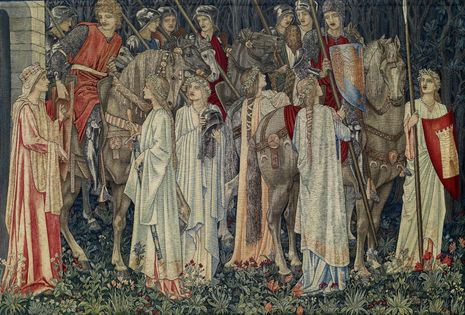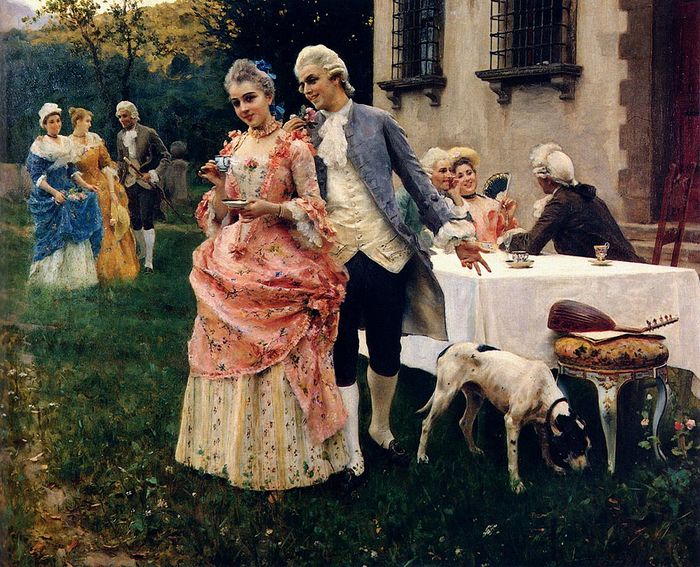The revival of medieval fashion
Elizabeth Middleton traces the evolving revival of medieval fashion through history and explores how it can be styled for the present day

In December 2024, Pinterest predicted that ‘castle-core’ would be a defining trend of 2025. ‘Castle-core’ has its roots in interior design, taking cues from castles, with its fashion being ‘gothic-inspired’. This prediction seems to have come to fruition, with a resurgence of interest in medieval-inspired clothing and aesthetics. Laird Borrelli-Persson points out in Vogue that while many designers for Fall 2025 may not have mentioned the medieval as a key touchstone of the season, “those far-away times were nonetheless in the air.”
Of course, recent years are not the first time that the medieval period has been looked to for artistic inspiration. Famously, the Arts and Crafts movement in the late nineteenth century took inspiration from medieval manuscripts for interior design and general crafts, such as in William Morris’s wallpaper and typefaces.
Also in the latter half of the nineteenth century were the Pre-Raphaelites. This group of artists was founded in 1848 and often portrayed the Middle Ages in art as a time of beauty, chivalry, and mysticism. It is no coincidence that this medieval revival coincided with the Industrial Revolution. As the world changed around them, artists and craftsmen looked back to what they perceived to be a simpler, more beautiful and more humane time.
“The references to medieval fashion seem to be an idealisation of medieval life, where community is centred and conflicts feel far away”
An era that is perhaps famous for medieval inspired fashion is the late 1960s and early 70s, where medieval silhouettes merged with the short hemlines and psychedelic colours of the decades. This was once again largely influenced by major social and political upheaval: the Civil Rights Movement and the reaction against the Vietnam War. Many people turned to fantasy as a form of escapism, with Tolkien’s books having a particularly strong impact. The references to medieval fashion seem to be an idealisation of medieval life, where community is centred and conflicts feel far away. The almost costume-like fashion appears to be a reflection of the utopia they thought could be created, where healthier traditional ways of living are reintroduced alongside equality and rights for all.
In 2025, the political climate is fraught, and for many people the world seems to be falling apart. With increased conflict and a rising awareness of social and political issues such as climate change and women’s healthcare rights, the resurgence of interest in the medieval world may be interpreted as a desire for a simpler and slower life. Once again people are trying to escape into a fantasy of armour and velvet. This is expressed mainly on social media, with creators like @nichefashiongirl on TikTok, coining the term ‘medieval weird core’, defined by mixing medieval inspiration with archive fashion.
The medieval revival that started online now seems to have bled onto the runway yet it is noticeably less colourful and costume-like. Instead, the medieval inspiration has been mixed with grunge and alternative aesthetics, resulting in a more gritty but also more wearable fashion, with key elements being leather, armour-like structure and dark muted colours. Perhaps this turn towards the edgier side of the medieval could be a reflection of the hopelessness that many younger generations feel towards life. While in previous revivals their reaction against industrialisation or injustices felt hopeful, a reflection of the idea that they could make real change, today’s revival feels harsher, simply an expression of what feels like an increasingly feudal world.
So how does one dress for a 2025 medieval revival? It may be helpful to take inspiration from this year’s fall runway where fashion houses like Schiaparelli and Burberry are focusing on an interplay of texture between soft fur and velvet with rough brocades and wools. There also appears to be a greater focus on structure: shoulders are broader, boots have become sturdy and layering takes precedence over the shape of the body. High street stores may not offer the patterns or silhouettes that one might desire for a medieval inspired look, so perhaps the key is in second hand clothing. On sites like Ebay and Vinted there are a wealth of unique and wearable pieces.
“Key materials to look out for would be leather, velvet, brocade, wool, or anything silver and shiny enough to look like armour in the right light”
Key materials to look out for would be leather, velvet, brocade, wool, or anything silver and shiny enough to look like armour in the right light. When it comes to the silhouette, search for structured or asymmetrical items; if an item appears distressed this may be to your advantage as it leans into the grittier side of today’s revival. Talking of grit, focus on colours that are more muted: browns and greens are perfect, but dark and moody jewel tones also work.
This is not to say that anything outside of this couldn’t be medieval-inspired. Medieval revivals have always been a form of escapism, a protest mixed with fantasy. The idealist view of the middle ages in the latter half of the 19th century and the psychedelic colours of the 60s and 70s demonstrate this. While 2025’s medieval revival is certainly visually harsher, that is not to say there is no joy to be found in taking inspiration from the strange yet wonderful medieval world.
 Comment / Plastic pubs: the problem with Cambridge alehouses 5 January 2026
Comment / Plastic pubs: the problem with Cambridge alehouses 5 January 2026 News / Cambridge academics stand out in King’s 2026 Honours List2 January 2026
News / Cambridge academics stand out in King’s 2026 Honours List2 January 2026 News / Cambridge businesses concerned infrastructure delays will hurt growth5 January 2026
News / Cambridge businesses concerned infrastructure delays will hurt growth5 January 2026 News / AstraZeneca sues for £32 million over faulty construction at Cambridge Campus31 December 2025
News / AstraZeneca sues for £32 million over faulty construction at Cambridge Campus31 December 2025 Interviews / You don’t need to peak at Cambridge, says Robin Harding31 December 2025
Interviews / You don’t need to peak at Cambridge, says Robin Harding31 December 2025










